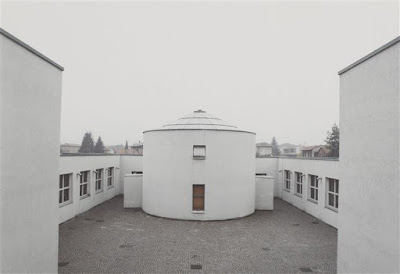It is the kind of tromp l'oeil picture that many an amateur has accidentally produced, but in this instance the result is so perfectly achieved that you want to know who is the photographer - and where exactly is he in relation to the other elements in the photo? Has he risen from some watery deep just beyond the frame? And when you learn that his name is Luigi Ghirri, you wonder why that name is not familiar.
Luigi Ghirri began his career with a sense that everything that could be done with photography had already been accomplished. He spoke often of how deeply affected he was by the view of Earth photographed from the Apollo 11 spacecraft. "It was not only the image of the entire world, but the image that contained all other images of the world." From this, Ghirri extrapolated the idea of the image-within-image, a framing technique he would use in his photographs. He brought the eye of an anthropologist to bear on the seemingly unremarkable sights that we see everyday but with an intensity that has been described as metaphysical, a word often applied to artists of Emilia-Romagna region, like Giorgio de Chirico and Giorgio Morandi. Ghirri called them his "sentimental geography" but that does not exhaust the interest of, say, those yellow traffic lights bobbing in the fog
Luigi Ghirri (1943-1992) grew up in the northern province of Emilia-Romagna. A temperate area of broad fertile plains, fed by the Po River, it was created millennia ago when the sea retreated, leaving marshlands as it retreated. The young Ghirri moved to Modena, a small city but no backwater, located near Bologna, the regional capitol and home of the oldest university in the world. His studies in surveying and graphic design coalesced in a new hobby - taking pictures - that quickly became his chosen work.

Conceiving his photographs mostly in series, Ghirri presented them in books more often than in exhibitions which may have limited their initial impact. His first book Kodachrome, published in 1978, featured the tightly cropped images that would familiar in his work.
Ghirri's last home was at Roncosesi, not far from where he was born. Although he traveled, he found all that he needed for his work there. Formal, cerebral, witty, Ghirri always intended his photographs to explore rather than merely represent what was before him.
“Everything has a blighted, faded quality about it now. Still, if you look at it for a long time, the old charm reemerges. And that is why I can see that I will lose absolutely nothing by staying where I am, even by contenting myself with watching things go by, like a spider in its web waiting for flies. You need to look at things for a long time…” – Vincent van Gogh
Ghirri copied this quotation from a letter written by Vincent Van Gogh to his brother Theo in his own journal.
Although admired during his lifetime, Ghirri's work has only grown in importance since his untimely death from a heart attack at the age of forty-nine. "...(N)ow, in their faded and aging present state, Ghirri’s prints from the 1970s and ’80s signal themselves as relics of the first wave of the then-new colour photography, carrying with them both prescience and nostalgia.." Christy Lange wrote for Frieze in 2011.
In 2009, the Aperture Gallery in Manhattan hosted the retrospective It's Beautiful Here, Isn't It?, devoted to the work of the Italian photographer Luigi Ghirri (1943-1992). Then, in 2013, Matthew Marks Gallery, also in New York, devoted an exhibition to Luigi Ghirri: Kodachrome. This exhibition coincides with the republication of Ghirri's much admired book Kodachrome, by MACK, London, UK: 2012., a book he originally published himself in 1978.
Images: The estate of Luigi Ghirri is represented by Matthew Marks Gallery, NYC.
1. Paris (self-portrait in reflection), 1976, reprinted from Kodachrome, 1978, reprinted London: 2012.
1. Paris (self-portrait in reflection), 1976, reprinted from Kodachrome, 1978, reprinted London: 2012.
2. Valli Grandi - Veronese, undated.
3. Fagnano Olona - elementary school designed by Aldo Rossi, 1985, Pompidou Center, Paris.
4. Reggio Emilia, 1973, Pompidou Center, Paris.
3. Fagnano Olona - elementary school designed by Aldo Rossi, 1985, Pompidou Center, Paris.
4. Reggio Emilia, 1973, Pompidou Center, Paris.


